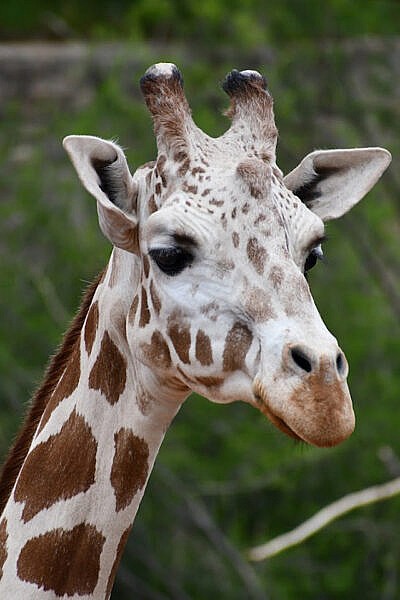
Mahali, a 20-year-old male giraffe at CMZoo, is showing signs of reduced mobility and range of motion. While his care team supports him with pain medications and a sand-mix stall to rest comfortably on each night, veterinary and animal care teams have made the decision to move into a mindset of providing hospice care for him. This is a difficult decision for his team.
“He’s still having more good days than bad days, and although we know how quickly that could change, we’re focused on giving him every possible bonus day he can comfortably have,” said Jason Bredahl, animal care manager in African Rift Valley at CMZoo. “That also means we have decided not to provide extreme medical intervention going forward.”
Mahali has benefitted from his medical team going to great lengths for him in the past. For many years, he voluntarily participated in training for hoof care, blood draws and even applying orthopedic shoes to his hooves. In 2017 and 2020, Mahali went under anesthesia to receive simultaneous multiple treatments for his reoccurring foot and leg issues. Those risky, meticulously planned procedures successfully helped him heal and return to a good quality of life.
“Without his most recent treatment, in 2020, we might not have had these last three years with him,” said Bredahl. ” Mahali is doing well, considering his individual challenges, but we know he won’t be here forever and his time may come sooner than later. Right now, we’re committed to making him comfortable, and providing opportunities to be as active as possible and social with his herd.”
Mahali takes oral anti-inflammation and pain medications – in yummy rye cracker-and-honey ‘sandwiches.’ His team tracks quality-of-life data markers that they discuss regularly to ensure Mahali is still able to do things that fulfill him as a giraffe and as an individual. The team tracks Mahali’s specific activities daily and overnight, so they can adjust medications or activity levels for him as needed.

“We want to see Mahali finding areas to stand and rest more comfortably, interacting with the herd, walking, eating, sleeping, lying down and getting up safely,” said Bredahl. “On days we see he’s a little stiffer, we might encourage him to stay in the barn on a nice soft sand-mix stall, and he may agree that it’s a rest day or he may decide to go outside. He still participates and moves to spaces when we ask him, but he’s still making choices in his care.”
Mahali’s care team says he’s still making them laugh with his antics, too. He may have slowed down as he has aged, but they still see a twinkle in his eye and respect his position in the herd.
“When he was younger, he was a very physical giraffe,” said Brehahl. “He was tactile in those days, and he would push other giraffe out of the way to position himself front-and-center with his care team. He’d pull on our shirts with his lips to get our attention, and to interact with us and get snacks. These days, he seems more content in his own space.”
Mahali’s keepers say he has become more discerning in his golden years, and he only accepts certain food items as training rewards. If they offer lettuce as an incentive, he spits it out with a seemingly intentional aim for the keeper who offered it to him. Then he huffs at them until they reset for a behavior that will earn him his favorite: rye crackers. They have to save the crackers for the big training asks, like curling his hoof on the hoof block so they can visually check his feet, but Mahali doesn’t miss an opportunity to remind them he’d rather not waste his time on lettuce.
“You’ve got to admire the guy – he knows his worth,” said Bredahl. “He’s a big giraffe and a big presence in the herd, and we’re grateful for every day we will have with him.”
Mahali is one of five giraffe in CMZoo’s herd over the age of 20 – four years and more over the median life expectancy. Nearly one-third of the herd is considered aging. Females Muziki (25), Amani (24), Twiga (23) and Lakeisha (23) are the eldest members of the herd, and all receive various levels of care for age-related issues, depending on their individual needs.
The median life expectancy for a giraffe, according to the Association of Zoos and Aquariums, is 16 years. Until recent data, which combines the median life expectancy for males and females, the AZA median life expectancy for a male giraffe was 14.7 years.

